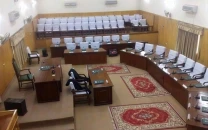The Reko Diq saga : Province can develop copper mine on its own
Balochistan can develop copper reserves at less than one-third cost estimated by Tethyan Copper Company.

The sources, who played an important role in the preparation of the PC-1 for the project as approved by the Executive Committee of the National Economic Council (Ecnec) on Thursday, said that the PC-1 provides for the setting up of a smelter and refinery at the mining site, doing away with the most expensive component of the project estimated at $2 billion by the consortium.
The consortium had proposed that copper concentrate would be transported from Reko Diq to Gwadar via a 600-kilometre-long pipeline for shipment to a smelter outside the country. Another important cost of the feasibility study was the provision for setting up a power plant.
Officials point out that Saindak Copper project, located only 40 kilometres from Reko Diq, was importing power from Iran and a similar arrangement could be worked out by the provincial government.
TCC, a joint venture between a Chilean and a Canadian company, carried out exploration for copper at Reko Diq in Chaghai district of Balochistan and estimates to have invested $220 million in identifying the potential areas suitable for mining. It had, obviously, sought rights to develop the mine.
According to the thinking in official quarters, Balochistan can easily set up a company to develop the mine and related facilities. An arrangement could be worked out with the consortium whereby it would be repaid its investment incurred on the exploration activities.
How we got here
The exploration licence for the Reko Diq project was originally awarded to BHP of Australia in 1993, which incorporated the Tethyan Copper Company in collaboration with another Australian company, Mincor Resources.
TCC was subsequently sold to its present owners, Barrick Gold Corporation of Canada and Antofagasta of Chile.
It is relevant to mention that a Chinese company, China Mining and Metallurgical Corporation (CMMC), has been mining copper in the area (Saindak) for more than a decade. Industry sources in Islamabad say that the Chinese company has also quietly lobbied to secure the mining licence for Reko Diq.
The reserves at Reko Diq are estimated to be four times larger than the Saindak mine.
Under the licencing agreement, a foreign company could not sell its interest without permission of the government. When and under what terms and conditions BHP sold its interest in the present consortium is a mystery, but the process took place under a deed of waiver and consent signed by the company with the provincial government in 2000.
A senior government official who took part in the negotiations with TCC on the directive of former prime minister Shaukat Aziz said that he had pointed out to then prime minister that Pakistan was not getting a fair deal but the main consideration at that time was to attract foreign companies to Pakistan.
The official recalled that even at the time of awarding the licence for exploration, there was talk of incorporating a provision in the agreement for arbitration.
According to the concerned officials, TCC had initially proposed a ridiculous two percent royalty to the Balochistan government but subsequently revised it to 25 per cent share in profits, subject to 25 per cent equity.
It was proposed that if the Balochistan government was not in position to pay the equity, its share would be deemed paid and adjusted against future payments.
Eyebrows were also raised in August this year, when TCC submitted a feasibility study for initial development of the mine estimated at $3.3 billion. The biggest component worth $2 billion was laying of a pipeline from Reko Diq to Gwadar for transportation of the slurry bearing copper.
From Gwadar, this slurry would be shipped to a smelter either in Chile or another country in the region where copper content would be separated chemically.
Officials highlighted that underground transportation of concentrated ore was not only an impractical proposition but would also rob the province of ascertaining the worth of mine’s produce. They were also quick to point out that the Chinese company mining copper at Saindak has set up a smelter at the site.
The PC-1 approved by the Planning Commission provides for an indigenous smelter to process 15,000 tons of ore per day with its own refining facilities.
“The whole project proposed by the Planning Commission would cost a maximum of $1 billion. The mining and processing of ore and its downstream utilisation would generate badly needed employment as well as give Balochistan control over its wealth,” said a Planning Commission official.
The estimates of yield from copper reserves at Reko Diq being mentioned in the media are mind-boggling. At the prevailing copper prices of $8,000 per ton, they are estimated at over $220 billion. This is in addition to the gold yield from the reserves whose real worth remains unknown.
To date, all negotiations for exploration and mining licences have been held by the ministry of petroleum and natural resources but the scenario has radically changed with passing of the 18th constitutional amendment.
The exploration licence is expiring in February 2011 and TCC has already submitted its proposal for development of the mine.
One can only hope that court proceedings related to the project end in a test case whereby various aspects of wheeling and dealing of corruption by big companies, bureaucracy and politicians is brought to the front.
A regional game
The Pakistani Taliban are smuggling truck-loads of copper ores, including gold, from tribal South Waziristan to China, sources in industry and the Federally Administered Tribal Area secretariat have claimed.
They say large copper deposits have been found in South Waziristan and that drilling and surveys estimate reserves exceeding 122 million tons across a large area, particularly at Shiniyaee and Boya in the tribal agency.
Industry sources say that the truck-loads are perhaps meant for chemical analysis of the ore reserve believed to have contents of gold and cobalt. Although the area is commanded by the Taliban, the Fata secretariat is busy working on a proposal to mine and develop the ore.
The copper reserves at South Waziristan are part of the great copper belt originating from Tibet and transiting through Pakistan to Iran, Afghanistan and Azerbaijan in Central Asia. The belt stretches from Gilgit-Baltistan in the north to Balochistan in the south, near the border with Iran and Afghanistan. Concentration, however, has been identified at South Waziristan, Saindak and Reko Diq.
Meanwhile, the Chinese are mining copper at Monywa in the Tibetan Plateau and Saindak in Balochistan. They have also expressed interest in mining the copper reserves of the Tethyan Metallogenic Belt at Reko Diq, located about 40 kilometres from Saindak. They have already secured rights to mine the copper reserves in Afghanistan.
Published in The Express Tribune, December 13th, 2010.



















COMMENTS
Comments are moderated and generally will be posted if they are on-topic and not abusive.
For more information, please see our Comments FAQ